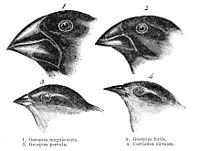
Photo from wikipedia
When environmental conditions differ both within and among populations, multiscale adaptation results from processes at both scales and interference across scales. We hypothesize that within‐population environmental heterogeneity influences the chance… Click to show full abstract
When environmental conditions differ both within and among populations, multiscale adaptation results from processes at both scales and interference across scales. We hypothesize that within‐population environmental heterogeneity influences the chance of success of migration events, both within and among populations, and maintains within‐population adaptive differentiation. We used a simulation approach to analyse the joint effects of environmental heterogeneity patterns, selection intensity and number of QTL controlling a selected trait on local adaptation in a hierarchical metapopulation design. We show the general effects of within‐population environmental heterogeneity: (i) it increases occupancy rate at the margins of distribution ranges, under extreme environments and high levels of selection; (ii) it increases the adaptation lag in all environments; (iii) it impacts the genetic variance in each environment, depending on the ratio of within‐ to between‐populations environmental heterogeneity; (iv) it reduces the selection‐induced erosion of adaptive gene diversity. Most often, the smaller the number of QTL involved, the stronger are these effects. We also show that both within‐ and between‐populations phenotypic differentiation (Q ST) mainly results from covariance of QTL effects rather than QTL differentiation (F STq), that within‐population QTL differentiation is negligible, and that stronger divergent selection is required to produce adaptive differentiation within populations than among populations. With a high number of QTL, when the difference between environments within populations exceeds the smallest difference between environments across populations, high levels of within‐population differentiation can be reached, reducing differentiation among populations. Our study stresses the need to account for within‐population environmental heterogeneity when investigating local adaptation.
Journal Title: Journal of Evolutionary Biology
Year Published: 2022
Link to full text (if available)
Share on Social Media: Sign Up to like & get
recommendations!